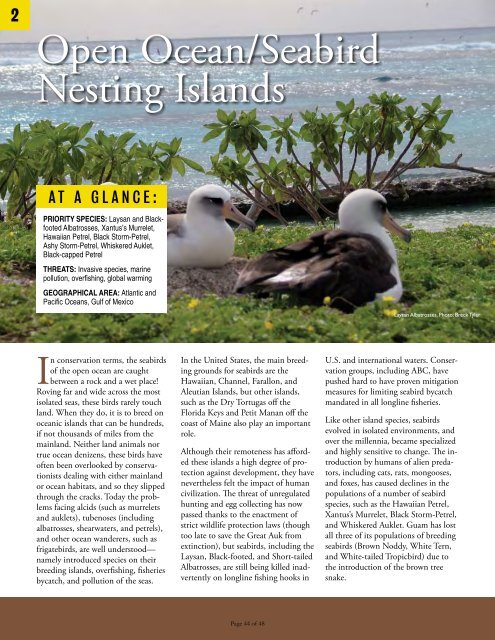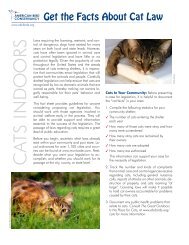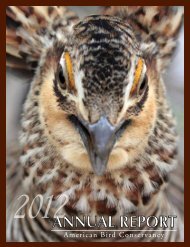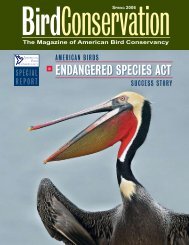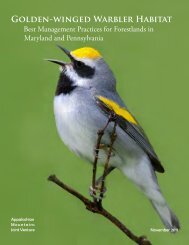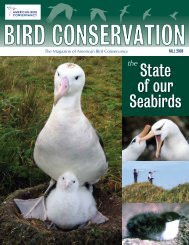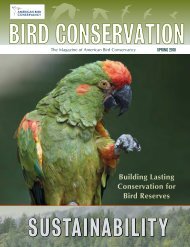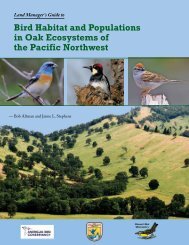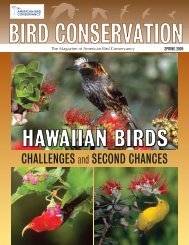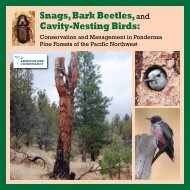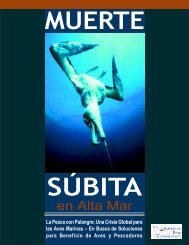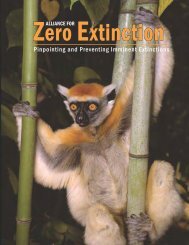2Open Ocean/SeabirdNest<strong>in</strong>g IslandsA T A G L A N C E :Priority Species: Laysan and BlackfootedAlbatrosses, Xantus’s Murrelet,Hawaiian Petrel, Black Storm-Petrel,Ashy Storm-Petrel, Whiskered Auklet,Black-capped PetrelThreats: Invasive species, mar<strong>in</strong>epollution, overfish<strong>in</strong>g, global warm<strong>in</strong>gGeographical area: Atlantic andPacific Oceans, Gulf of MexicoLaysan Albatrosses. Photo: Breck TylerIn conservation terms, <strong>the</strong> seabirdsof <strong>the</strong> open ocean are caughtbetween a rock and a wet place!Rov<strong>in</strong>g far and wide across <strong>the</strong> mostisolated seas, <strong>the</strong>se birds rarely touchland. When <strong>the</strong>y do, it is to breed onoceanic islands that can be hundreds,if not thousands of miles from <strong>the</strong>ma<strong>in</strong>land. Nei<strong>the</strong>r land animals nortrue ocean denizens, <strong>the</strong>se birds haveoften been overlooked by conservationistsdeal<strong>in</strong>g with ei<strong>the</strong>r ma<strong>in</strong>landor ocean habitats, and so <strong>the</strong>y slippedthrough <strong>the</strong> cracks. Today <strong>the</strong> problemsfac<strong>in</strong>g alcids (such as murreletsand auklets), tubenoses (<strong>in</strong>clud<strong>in</strong>galbatrosses, shearwaters, and petrels),and o<strong>the</strong>r ocean wanderers, such asfrigatebirds, are well understood—namely <strong>in</strong>troduced species on <strong>the</strong>irbreed<strong>in</strong>g islands, overfish<strong>in</strong>g, fisheriesbycatch, and pollution of <strong>the</strong> seas.In <strong>the</strong> United States, <strong>the</strong> ma<strong>in</strong> breed<strong>in</strong>ggrounds for seabirds are <strong>the</strong>Hawaiian, Channel, Farallon, andAleutian Islands, but o<strong>the</strong>r islands,such as <strong>the</strong> Dry Tortugas off <strong>the</strong>Florida Keys and Petit Manan off <strong>the</strong>coast of Ma<strong>in</strong>e also play an importantrole.Although <strong>the</strong>ir remoteness has afforded<strong>the</strong>se islands a high degree of protectionaga<strong>in</strong>st development, <strong>the</strong>y havenever<strong>the</strong>less felt <strong>the</strong> impact of humancivilization. The threat of unregulatedhunt<strong>in</strong>g and egg collect<strong>in</strong>g has nowpassed thanks to <strong>the</strong> enactment ofstrict wildlife protection laws (thoughtoo late to save <strong>the</strong> Great Auk fromext<strong>in</strong>ction), but seabirds, <strong>in</strong>clud<strong>in</strong>g <strong>the</strong>Laysan, Black-footed, and Short-tailedAlbatrosses, are still be<strong>in</strong>g killed <strong>in</strong>advertentlyon longl<strong>in</strong>e fish<strong>in</strong>g hooks <strong>in</strong>U.S. and <strong>in</strong>ternational waters. Conservationgroups, <strong>in</strong>clud<strong>in</strong>g ABC, havepushed hard to have proven mitigationmeasures for limit<strong>in</strong>g seabird bycatchmandated <strong>in</strong> all longl<strong>in</strong>e fisheries.Like o<strong>the</strong>r island species, seabirdsevolved <strong>in</strong> isolated environments, andover <strong>the</strong> millennia, became specializedand highly sensitive to change. The <strong>in</strong>troductionby humans of alien predators,<strong>in</strong>clud<strong>in</strong>g cats, rats, mongooses,and foxes, has caused decl<strong>in</strong>es <strong>in</strong> <strong>the</strong>populations of a number of seabirdspecies, such as <strong>the</strong> Hawaiian Petrel,Xantus’s Murrelet, Black Storm-Petrel,and Whiskered Auklet. Guam has lostall three of its populations of breed<strong>in</strong>gseabirds (Brown Noddy, White Tern,and White-tailed Tropicbird) due to<strong>the</strong> <strong>in</strong>troduction of <strong>the</strong> brown treesnake.Page 44 of 48
Introduced ungulates can be asdevastat<strong>in</strong>g as <strong>the</strong> predators. Leftunchecked, <strong>in</strong>troduced goats, sheep,cattle, and horses can wreak havoc onnative habitat and trample groundnests. Even <strong>in</strong>troduced plant speciescan compromise seabird nest<strong>in</strong>g colonies,such as golden crown-beard onMidway Atoll (see below).One advantage of islands is that <strong>the</strong>yare, by def<strong>in</strong>ition, enclosed ecosystems,and are frequently relatively small.This can make removal of <strong>in</strong>vasivespecies easier than on <strong>the</strong> ma<strong>in</strong>land.The National Park Service successfullyremoved rats from Anacapa and o<strong>the</strong>rCalifornian Channel Islands to aid <strong>in</strong><strong>the</strong> recovery of <strong>the</strong> Xantus’s Murreletand Ashy Storm-Petrel; and on WakeIsland, between Hawaii and Guam, acoalition of groups removed feral catsto protect Wedge-tailed Shearwaters.Removal of <strong>the</strong> brown tree snake fromGuam will be considerably harder,however, despite recent legislation thatprovided much needed federal fund<strong>in</strong>g.Conservationists are desperatelyXantus's Murrelets: Glen Tepkeguard<strong>in</strong>g aga<strong>in</strong>st <strong>the</strong> possible spreadof this <strong>in</strong>vasive predator to Hawaii,where it could devastate rema<strong>in</strong><strong>in</strong>gnative bird populations.While at sea, ocean-go<strong>in</strong>g birds facea mount<strong>in</strong>g barrage of threats. With<strong>the</strong> <strong>in</strong>troduction of double-hulledtankers, oil spills are decreas<strong>in</strong>g, butmany operators still risk catastropheby us<strong>in</strong>g old, s<strong>in</strong>gle-sk<strong>in</strong>ned vessels.Tanker spills only account for 10-12%of mar<strong>in</strong>e oil pollution, however.An estimated 550,000 tons of oil isreleased <strong>in</strong>to <strong>the</strong> oceans each year frompipel<strong>in</strong>e ruptures and <strong>the</strong> cont<strong>in</strong>uousdischarge emanat<strong>in</strong>g from ships andland-based sources. An ever-grow<strong>in</strong>gaccumulation of plastic trash drifts onocean currents to <strong>the</strong> fur<strong>the</strong>st reachesof <strong>the</strong> globe. Mistak<strong>in</strong>g <strong>the</strong>se items forsmall fish, albatrosses consume bottlecaps, cigarette lighters, toothbrushes,and all manner of household objects,often with fatal consequences.Ultimately, seabirds are reliant onocean-based food cha<strong>in</strong>s for survival.Overfish<strong>in</strong>g has changed <strong>the</strong> compositionof ocean life almost beyond comprehension,with far reach<strong>in</strong>g effects.Some U.S. fisheries are beg<strong>in</strong>n<strong>in</strong>gto come under better management,but without significant changes toglobal fish<strong>in</strong>g practices, seabirds willcont<strong>in</strong>ue to feel <strong>the</strong> effects of decl<strong>in</strong><strong>in</strong>gfood supplies. These effects arelikely to be compounded by globalclimate change, <strong>the</strong> extent and impactof which is becom<strong>in</strong>g ever more apparent.While we cannot predict howseabirds will fare with ris<strong>in</strong>g temperaturesand sea levels, it is likely that<strong>the</strong>ir current population decl<strong>in</strong>es andsensitivity to habitat change will notdispose <strong>the</strong>m favorably.HABITAT CONSERVATION SPOTLIGHTMore than two million seabirds live on Midway Atoll <strong>in</strong> <strong>the</strong>Hawaiian cha<strong>in</strong>, <strong>in</strong>clud<strong>in</strong>g <strong>the</strong> Black-footed Albatross and<strong>the</strong> world’s largest populations of <strong>the</strong> Laysan Albatross. Introducedrats that once plagued <strong>the</strong> island have now beeneradicated, but o<strong>the</strong>r <strong>in</strong>vasives, most notably two species of plants,are now wreak<strong>in</strong>g havoc.Ironwood (a large tree that <strong>in</strong>vades open areas) and golden crownbeard,have overrun parts of Midway. Golden crown-beard (a relativeof <strong>the</strong> sunflower) out-competes native vegetation, grow<strong>in</strong>g well even<strong>in</strong> sand and <strong>in</strong> cracks <strong>in</strong> asphalt, and forms dense stands wherealbatrosses cannot nest. It also grows so rapidly that chicks canbecome enclosed by thick walls of vegetation while still <strong>in</strong> <strong>the</strong> nest.Unable to extricate <strong>the</strong>mselves or be reached by <strong>the</strong>ir parents, somechicks starve.Beg<strong>in</strong>n<strong>in</strong>g <strong>in</strong> <strong>the</strong> late 1990s, <strong>the</strong> U.S. Fish and Wildlife Service <strong>in</strong>itiateda golden crown-beard management program on Midway, whichwas <strong>in</strong>tensified <strong>in</strong> <strong>20</strong>03. The program has <strong>in</strong>cluded control by handpull<strong>in</strong>g,mow<strong>in</strong>g, and herbicide application. In areas where goldencrown-beard has been eradicated, native plants are propagated toprevent <strong>the</strong> <strong>in</strong>vasive from recoloniz<strong>in</strong>g. In <strong>20</strong>06, <strong>the</strong> National Fishand Wildlife Foundation’s Pull<strong>in</strong>g Toge<strong>the</strong>r <strong>in</strong>itiative awarded a grantto <strong>the</strong> Friends of Midway Atoll National Wildlife Refuge to help withpropagation of native plants and provide volunteers to help removegolden crown-beard. ABC and <strong>the</strong> Biological Conservation AssistanceProgram are also assist<strong>in</strong>g <strong>in</strong> this effort.Conservationists hope that <strong>the</strong> recent designation of <strong>the</strong> NorthwestHawaiian Islands as a National Monument will promote new sourcesof fund<strong>in</strong>g to help rid Midway of its most harmful <strong>in</strong>vasive species, aswell as f<strong>in</strong>anc<strong>in</strong>g <strong>the</strong> removal of lead-based pa<strong>in</strong>t from former Navybarracks on <strong>the</strong> island. Hundreds of curious young albatrosses havebeen poisoned after eat<strong>in</strong>g peel<strong>in</strong>g pa<strong>in</strong>t that affects <strong>the</strong>ir nervoussystems. With an estimated cost of $6 million, <strong>the</strong> cleanup will requirea substantial commitment from federal regulators, but ABC, withsupport from Lynn White and <strong>the</strong> LannanFoundation, is push<strong>in</strong>g hard to ensure that<strong>the</strong> build<strong>in</strong>gs are made safe for futuregenerations of Laysan and BlackfootedAlbatrosses on Midway.—Christy F<strong>in</strong>layson, Friends ofMidway and Jennifer Arnold, ABCLaysan Albatross chick <strong>in</strong> golden crown-beard: Christy F<strong>in</strong>laysonPage 45 of 48


